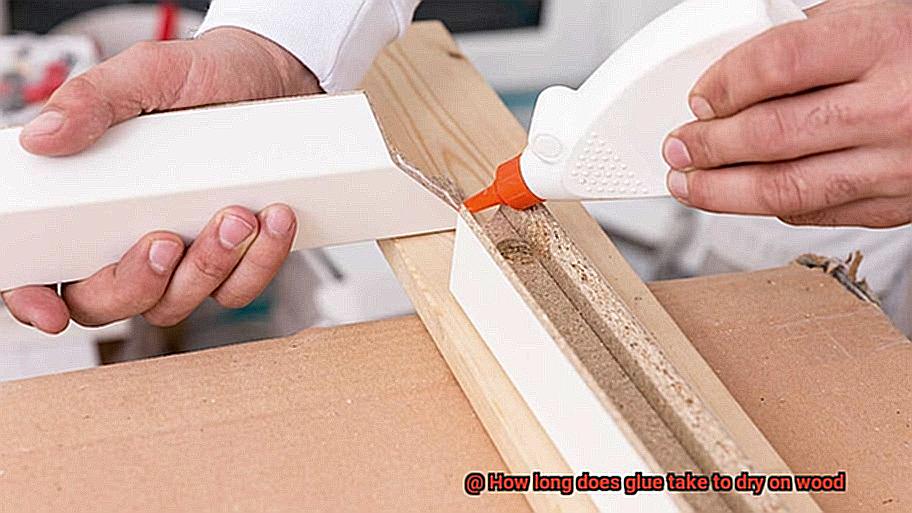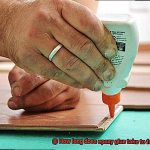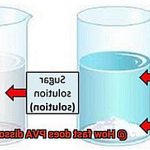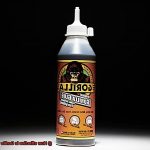Are you a DIY enthusiast who loves woodworking projects? If yes, then you know the importance of glue in your work. Glue helps to bond pieces of wood together, giving your project a sturdy and seamless finish. However, have you ever found yourself wondering how long it takes for glue to dry on wood? If so, you’re not alone.
Different types of glue have different drying times. For instance, PVA (polyvinyl acetate), epoxy, and cyanoacrylate are popular types of wood glue that can take anywhere from a few minutes to several hours to dry. The brand and environmental conditions also play a significant role in determining the drying time.
Moreover, the type of wood you’re gluing is another crucial factor to consider. Hardwoods like oak and mahogany tend to absorb moisture slower than softwoods like pine or spruce. Thus, they may require more time for the glue to dry. Additionally, the temperature and humidity levels in your workspace can affect how fast or slow the glue dries.
In this blog post, we’ll delve into the different types of wood glue and their drying times while considering other factors that may affect drying time. By the end of this article, you’ll be well-equipped with all the knowledge needed to ensure your next woodworking project is a success. So grab your favorite beverage and let’s get started.
Types of Glue and Drying Time
Contents
When it comes to woodworking, glue is an essential tool that can make or break a project. With various types of glue available in the market, it’s crucial to understand their characteristics and respective drying times to ensure a successful project.

PVA (polyvinyl acetate) glue is a popular choice for woodworking due to its easy application and non-toxic nature. This white glue dries quickly within 30 minutes to an hour, making it perfect for smaller projects. However, factors such as temperature and humidity levels can affect the drying time, so it’s important to check before using it.
Epoxy glue is another adhesive that is ideal for bonding wood with metal or plastic due to its waterproof and heat-resistant properties. Although it takes around 24 hours to fully cure, it provides a stronger bond than PVA glue, making it ideal for larger and more complex projects.
Superglue or cyanoacrylate glue is a fast-drying adhesive that can bond wood in just a few seconds. However, it’s not recommended for larger woodworking projects as it can become brittle and crack over time.
For complex woodworking projects requiring precise adjustments, hide glue made from animal collagen is an excellent option that dries slowly. On the other hand, polyurethane glue has a longer drying time of 4-6 hours but creates a strong bond that can withstand extreme temperatures and moisture.
Choosing the right type of glue is only half the battle; allowing enough drying time is equally important. Even if the surface appears dry after a few hours, the glue may not have dried completely. Waiting at least 24 hours before sanding or applying any finishing products ensures a strong and lasting bond for your woodworking project.
In conclusion, understanding the different types of glue and their respective drying times is crucial for woodworking success. Temperature and humidity levels can affect drying times, so it’s important to take them into consideration before using any type of glue.
Factors That Affect the Drying Time of Glue
It’s equally important to understand how different factors can affect the drying time of glue. As an expert on this subject, I’m here to share my knowledge and help you achieve optimal results for your woodworking projects.
First and foremost, the type of glue you use plays a significant role in determining how long it takes to dry. For example, PVA glues like white glue and school glue typically dry in 1-2 hours, while wood glues like Titebond III and Gorilla Wood Glue can take up to 24 hours to fully dry. Epoxy glues are also known for their varying drying times, ranging from 5 minutes to 24 hours depending on their strength.
Temperature and humidity levels are two other crucial factors that can impact the drying time of glue. In general, higher temperatures speed up the drying process while lower temperatures slow it down.
However, it’s important to be cautious as high temperatures can cause the glue to dry too quickly, resulting in weaker bonds. On the other hand, higher humidity levels can slow down the drying process, making it important to consider both temperature and humidity levels.
Finally, the type of wood being glued can also be a factor in determining how long it takes for glue to dry. Woods with tight grains like maple or oak can take longer to absorb glue and therefore take longer to dry. Softwoods like pine or spruce generally absorb glue more quickly and dry faster.
PVA (Polyvinyl Acetate) Glue
Today, let’s dive into the world of PVA glue and explore some of the fascinating aspects of this popular adhesive. As an expert in this field, I’m thrilled to share with you some insights into the drying time of PVA glue and how it can vary depending on several factors.
PVA (Polyvinyl Acetate) glue is an excellent choice for woodworking projects. It is a water-based adhesive that dries clear and has a strong bond. One of the best features of PVA glue is its user-friendly nature – it is easy to use, non-toxic, and can be cleaned up with water.
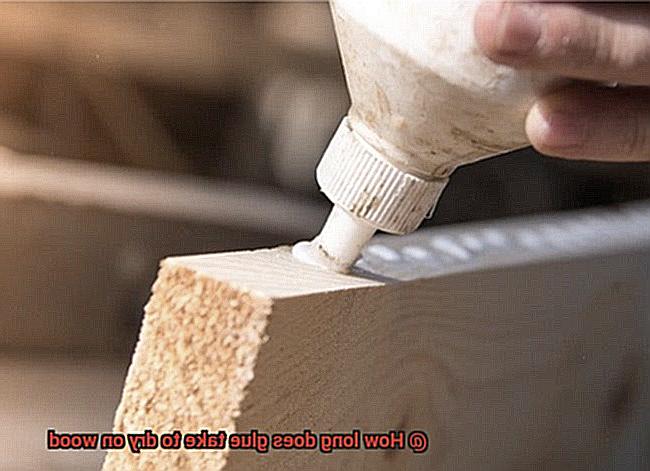
When it comes to drying time, there are several factors to consider. Firstly, the temperature of your workspace plays a significant role in how quickly PVA glue dries. If the temperature is too cold, it can slow down the drying process, while higher temperatures can speed it up.
Humidity levels are also critical – high humidity can make the glue take longer to dry, while low humidity can cause it to dry too quickly. Hardwoods like oak or maple may take longer to dry compared to softer woods like pine or spruce. This is because hardwoods have denser fibers that absorb moisture more slowly than softwoods.
Another essential factor to consider is the cleanliness of the surface being glued together. Any debris or dust particles on the surface can affect how well the glue will adhere and how long it will take to dry.
In general, it’s recommended to wait at least 24 hours before applying any pressure or stress to the glued areas. This allows enough time for the glue to fully cure and form a strong bond.
Epoxy Glue
This two-part adhesive is made up of a resin and hardener, and it is known for its ability to create a sturdy bond that can withstand even the toughest conditions.
But how long does it take for epoxy glue to dry on wood? The answer depends on several factors. First and foremost, temperature and humidity play a significant role in the drying time of epoxy glue. In general, warmer temperatures and lower humidity levels will speed up the drying process. On the other hand, cooler temperatures and higher humidity levels can slow it down.
The type of wood being used also affects how quickly the epoxy glue dries. Porous woods tend to absorb more of the adhesive, which can lead to longer drying times. Additionally, woods with high natural oil or moisture content may need more time to dry.
It’s worth noting that while epoxy glue may appear dry to the touch after a few hours, it can take several days to fully cure and reach maximum strength. So be patient.
To ensure the best results with epoxy glue on wood, follow the manufacturer’s instructions carefully. This may include mixing equal parts of the resin and hardener, applying the glue evenly to both surfaces being bonded, and clamping the wood together until the glue is fully cured.
Humidity Levels and Drying Time
You may have experienced the frustration of glue taking too long or drying too quickly. One significant factor that affects the drying time of glue on wood is humidity levels.
The amount of moisture in the air can significantly impact how long it takes for glue to dry on wood. Low humidity levels can cause glue to dry too quickly, leading to weak bonds that may break easily. Conversely, high humidity levels can cause the glue to dry too slowly, which can be frustrating if you have a deadline to meet.
However, did you know that different types of glue have different optimal humidity levels for drying? Polyurethane and epoxy glues tend to prefer low humidity environments, while PVA glues work best in environments with moderate humidity levels. It’s essential to read the manufacturer’s instructions carefully and check the recommended optimal humidity range for your chosen glue.
To ensure that the glue dries correctly, it’s vital to monitor the humidity levels in your workspace. You can use a hygrometer or check local weather reports for accurate readings. Proper ventilation during the drying process is also crucial as it regulates humidity levels and prevents moisture buildup around the glue.
To summarize:
- Low humidity levels can cause glue to dry too quickly, while high humidity levels can cause it to dry too slowly.
- Different types of glue have different optimal humidity levels for drying.
- Monitoring humidity levels using a hygrometer or checking local weather reports is recommended.
- Proper ventilation during the drying process helps regulate humidity levels and prevent moisture buildup around the glue.
Temperature and Drying Time
As an expert in temperature and drying time, I can tell you that finding the right balance is crucial.
Higher temperatures generally mean faster drying times. Heat causes the water or solvent in the glue to evaporate quickly, resulting in a solid bond. However, be cautious of too much heat. It can cause the glue to dry too quickly, leading to a weak bond that won’t last. High temperatures can also make the glue brittle, increasing the chances of cracking or breaking.
Conversely, cooler temperatures slow down the drying process. The water or solvent in the glue evaporates slowly, which means it takes longer to create a strong bond.
So what’s the optimal temperature for strong and timely drying? The answer is not one-size-fits-all. It may require some experimentation with different temperatures and types of glue to find what works best for your project and materials.
In addition to temperature, there are other factors that can affect drying time such as humidity levels, air circulation, and surface preparation. Here are some tips to keep in mind:
- Ensure a clean and dry surface before applying glue.
- Increase air circulation by using fans or opening windows.
- Monitor humidity levels as high humidity can slow down drying time.
Appearances Can Be Deceptive
It’s easy to assume that a glued joint is ready for use just by looking at it, but there are several factors that can affect the drying time of glue on wood, making appearances deceiving.
Firstly, the type of glue being used can significantly impact drying time. PVA glue, a commonly used adhesive in woodworking, can take anywhere from 20 minutes to several hours to dry. Therefore, just because the surface of the glue appears dry, it may not be fully cured and ready for use.
Secondly, temperature and humidity can also affect the drying time of glue on wood. Higher temperatures and lower humidity can shorten the drying time, while lower temperatures and higher humidity can lengthen it. It’s important to keep in mind that these factors can vary depending on where you live or work, making it crucial to adjust your expectations accordingly.
Lastly, the type of wood being used can also impact drying time. Certain types of wood may absorb more moisture from the glue, which can affect how long it takes for the adhesive to dry. This means that even if two pieces of wood are glued together with the same type of glue in the same environment, one may dry faster than the other due to the type of wood being used.
It’s important to remember that appearances can be deceiving when it comes to glue drying time on wood. Just because the surface of the glue appears dry, doesn’t mean that it’s fully cured and ready for use. It’s recommended to wait at least 24 hours before putting any stress on the glued joint, such as clamping or sanding. This allows the adhesive to fully cure and create a strong bond between the pieces of wood.
U0hhFjjW5EU” >
Also Read: How Long Does Super Glue Take to Dry?
Conclusion
In conclusion, the drying time of glue on wood is an essential factor in any woodworking project. With various types of glue available, each with different drying times, it’s crucial to choose the right one for your project. Temperature, humidity levels and the type of wood used can also significantly impact the drying process.
PVA glue is a popular choice due to its quick-drying nature, taking only 30 minutes to an hour to set. However, epoxy glue takes around 24 hours to fully cure and create a strong bond. Superglue or cyanoacrylate glue dries rapidly but is not recommended for larger projects. Hide glue made from animal collagen dries slowly and is ideal for complex woodworking projects requiring precise adjustments.
Choosing the right type of glue is just half the battle; allowing enough drying time is equally important. Even if the surface appears dry after a few hours, waiting at least 24 hours before sanding or applying any finishing products ensures optimal results.
Temperature and humidity levels play significant roles in determining how long it takes for glue to dry on wood. Monitoring these factors using a hygrometer or checking local weather reports during the drying process can help achieve optimal results.
In summary, understanding the different types of glue and their respective drying times, along with external factors that affect drying time, is crucial for woodworking success.

